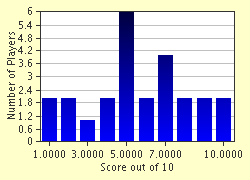Quiz Answer Key and Fun Facts
1. The Black Watch has been a part of British military history since the mid-18th century. In which constituent country of the United Kingdom did it originate?
2. British, Dutch and Hanoverian forces were defeated by the French at the Battle of Fontenoy in 1745. This was the first major military action in which the Black Watch (43rd Highland Regiment of Foot) were involved and took place during which war?
3. In 1758 the Black Watch was deployed in North America as part of the British forces involved in the French and Indian War. It suffered heavy losses at the Battle of Carillon - an attempt by the British to gain control of the French controlled Fort Carillon on Lake Champlain. By what name is the fort now better known?
4. The Black Watch adopted the red hackle - one of the most distinctive parts of their uniform - in 1795. But what exactly is a hackle?
5. The first soldier of the Black Watch to be awarded the Victoria Cross was Lieutenant Francis Farquharson. He won this honour in March 1858 for his "conspicuous bravery" during the capture of which Indian city that had been besieged the previous year?
6. During which conflict did a battalion of the Black Watch take part in the Siege of Kut, the Fall of Baghdad and the Battle of Megiddo?
7. The 1st, 4th and 6th battalions of the Black Watch were all sent to France in 1939 during the early stages of the Second World War, but evacuated from Dunkirk less than nine months later. True or False?
8. Which British castle is the home of the Black Watch and includes the regimental headquarters and a museum dedicated to its history?
9. In 2006, a reorganisation of the British Army resulted in the amalgamation of the Black Watch with other historic regiments. Black Watch then became the third battalion of which new regiment?
10. Which member of the Royal Family served as Colonel-in-Chief of the Black Watch from 1937 until 2002?
Source: Author
Fifiona81
This quiz was reviewed by FunTrivia editor
stedman before going online.
Any errors found in FunTrivia content are routinely corrected through our feedback system.


